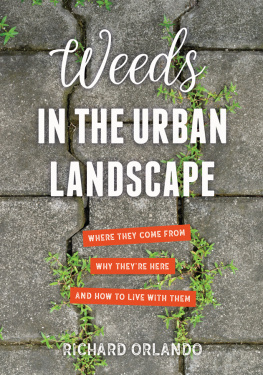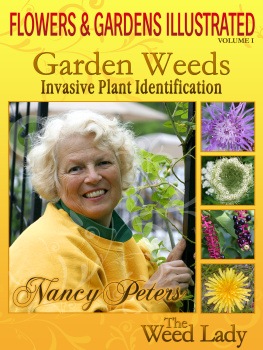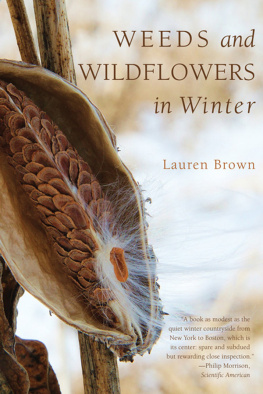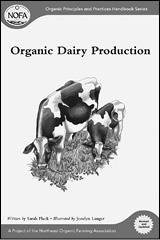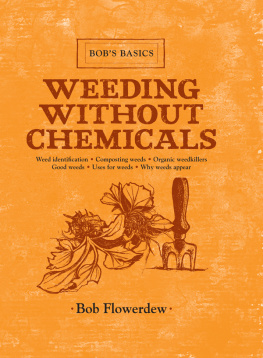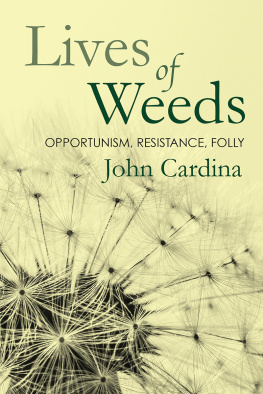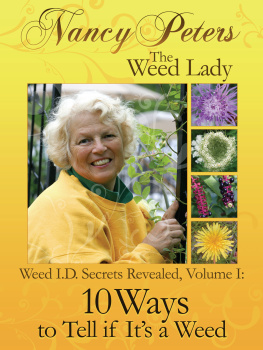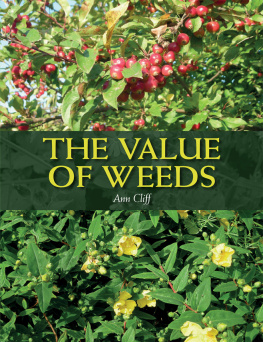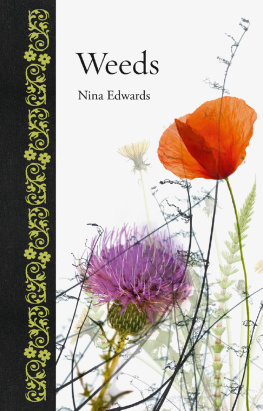
Copyright 2018 by Richard Orlando. All rights reserved. No portion of this book, except for brief review, may be reproduced, stored in a retrieval system, or transmitted in any form or by any meanselectronic, mechanical, photocopying, recording, or otherwisewithout the written permission of the publisher. For information contact North Atlantic Books.
Published by
North Atlantic Books
Berkeley, California
Cover photo edography/Shutterstock.com
Cover design by Jasmine Hromjak
Interior design by Happenstance Type-O-Rama
Printed in the United States of America
Pen and ink drawings copyright 2018 Estate of Tom Yutani
Weeds in the Urban Landscape: Where They Come from, Why Theyre Here, and How to Live with Them is sponsored and published by the Society for the Study of Native Arts and Sciences (dba North Atlantic Books), an educational nonprofit based in Berkeley, California, that collaborates with partners to develop cross-cultural perspectives, nurture holistic views of art, science, the humanities, and healing, and seed personal and global transformation by publishing work on the relationship of body, spirit, and nature.
North Atlantic Books publications are available through most bookstores. For further information, visit our website at www.northatlanticbooks.com or call 800-733-3000.
Library of Congress Cataloging-in-Publication Data
Names: Orlando, Richard, 1942- author.Title: Weeds in the urban landscape : where they come from, why theyre here, and how to live with them / Richard Orlando.Description: Berkeley, California : North Atlantic Books, [2018] | Includes bibliographical references and index.Identifiers: LCCN 2017043940 (print) | LCCN 2017049376 (ebook) | ISBN 9781623172121 (e-book) | ISBN 9781623172114 (pbk.)Subjects: LCSH: WeedsWest (U.S.)Identification. | WeedsControlWest (U.S.) | Urban gardeningWest (U.S.)Classification: LCC SB612.A2 (ebook) | LCC SB612.A2 O75 2018 (print) | DDC 632/.50978dc23LC record available at https://lccn.loc.gov/2017043940
North Atlantic Books is committed to the protection of our environment. We partner with FSC-certified printers using soy-based inks and print on recycled paper whenever possible.
To Kitty Hughes, the love of my life
Preface
Why I Wrote This Book
I first thought about writing this book when I began teaching a course on urban weeds at Merritt College, a community college in Oakland, and soon discovered that there was no single work available that would serve as an adequate text. I quickly cobbled together a reader, consisting of excerpts from various sources, as well as some articles I wrote myself and a list of all the weeds I knew that grew in the cities of the San Francisco Bay Area. I resolved to follow this with a book that would serve as a complete text for my class, and for similar classes that are taught in landscape horticulture programs in many other community colleges. These classes teach identification of weeds that grow in urban landscapes, and strategies and techniques for controlling them.
My class was originally called Weed Identification and Control and was almost entirely limited to these two tasksidentifying and naming the weeds, then learning all the options for controlling them. But what are weeds, and how do they differ from plants that are not weeds? The answer I was taught was that they were simply unwanted plants, but I soon discovered that the real answer was a lot more complex. Weeds belong to a specific group of plants that follow us around, that are supremely well adapted to colonizing the bare, disturbed ground that humans have created since the beginnings of civilization. They have a history, inextricably intertwined with our history, and referred to in our folklore and literature. This realization added a new and fascinating dimension to how I viewed my course. I incorporated information on the historical, folkloric, and literary aspects of weeds into my lectures and reader. I renamed the course Weeds in the Urban Landscape, a name that I have also chosen as the title of my book.
There are many textbooks available for weed identification and control classes, but these are mostly oriented toward weeds growing in agricultural situations; none of them work well for students who are trying to focus on the assemblage of weeds present in urban areas and the particular problems associated with them. I hope my book will fill this gap and also be of interest to general readers who are curious about this wonderfully varied and interesting group of plants that pop up everywhere and are usually labeled merely as weeds, a term often uttered with a dismissive sneer.
The book assigned at Merritt when I took the late Emile Labadies weeds course in the 1970s was W. W. Robbinss Weeds of California, which still serves well as a field guide to weeds in my home state and includes most of those found in cities. It has been out of print since 1970, more than forty-five years, a period that has seen many changes in both urban and rural weed populations, as well as botanical nomenclature; yet, it is still very useful, if you can find a used copy. Robbinss book contains some information on weed control techniques, but mostly focuses on identification.
Shortly after Weeds of California ceased being printed, the University of California began publishing the Growers Weed Identification Handbook, a collection of sheets with descriptions and color photographs set in a ring binder, so that more could be added as they were produced. By 1978, this publication covered over 200 weeds; the last revision I know of contained 312 species, including most of those present in urban areas. Used copies of this publication are still available but are very expensive.
In 1991, a group of cooperative extension scientists who belonged to the Western Society of Weed Science collaborated to produce an identification guide to weeds of the western states that they titled Weeds of the West. This is a hefty volume, containing clear, vibrant photographs of all the weeds it describes. I considered assigning it as a text but found that it contains many weeds that are present only in rural areas and is missing many that are common in West Coast cities.
In 2007, Joseph DiTomaso, a renowned UC Davis weed scientist, and coauthor E. A. Healy published their massive two-volume Weeds of California and Other Western States. Illustrated with many color photos, this book is the most comprehensive and accurate guide to the weeds present in rural, wild land, and urban areas of California and adjoining states. It is a definitive reference work, but it is too massive to serve as a handy field guide, or even as a textbook.
My book has a threefold purpose. It will serve as an identification guide to weeds I have observed growing in urban environments of the San Francisco Bay Area and other West Coast cities. It will also help gardeners and pest control specialists working in these environments implement integrated control strategies, that is, set priorities, determine what tools are available, and devise comprehensive plans for achieving the needed level of control. But my motivation for writing this book goes beyond these utilitarian concerns. I truly believe that developing an understanding of the natural and historical contexts in which weeds developed and continue to thrive is essential for defining our relationship to a natural environment that we have irrevocably altered, and that we now dominate. The current era, called by some the Anthropocene, is a time in which we must learn to live lightly, and in harmony with our fellow creatures. I think all of our activities need to be informed by this perspective.
Next page
